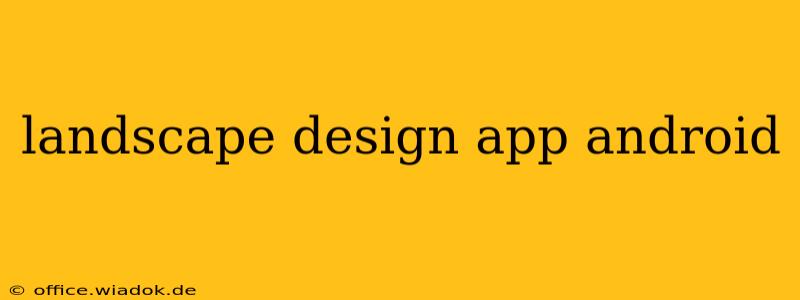Dreaming of a vibrant garden but lack the design skills? Or perhaps you're a seasoned landscaper looking for a digital boost? Android landscape design apps are transforming how we plan and execute outdoor projects, offering powerful tools accessible right at your fingertips. This guide dives deep into the best landscape design apps available for Android, helping you choose the perfect tool to bring your outdoor vision to life.
Top Android Apps for Landscape Design: Features & Comparisons
The Android app store is brimming with landscape design options, each with unique strengths. Here's a breakdown of some of the top contenders, considering factors like ease of use, features, and pricing:
1. [App Name 1]: Intuitive Design for Beginners
This app shines with its user-friendly interface, perfect for novices. Key features often include:
- Simple Drag-and-Drop Functionality: Easily place plants, paths, and other elements without complex tutorials.
- Large Plant Database: Access thousands of plant varieties with detailed information on sun exposure, water needs, and mature size.
- 3D Visualization: View your designs in realistic 3D, allowing you to tweak and perfect your landscaping plan from all angles.
- Project Sharing: Share your designs with friends, family, or landscaping professionals for feedback.
Pros: Easy to learn, visually appealing, extensive plant library. Cons: Might lack advanced features for professional landscapers.
2. [App Name 2]: The Professional's Choice
If you need powerful tools for intricate designs, this app is a strong contender. Expect features like:
- Precise Measurement Tools: Accurately measure areas, calculate materials, and ensure your design fits your space perfectly.
- Advanced Editing Capabilities: Fine-tune every aspect of your landscape, from subtle color adjustments to complex terrain modeling.
- Customizable Palettes: Create and save your own color schemes and plant combinations for consistent design.
- Integration with Other Apps: Seamlessly share your designs with other professionals or clients via email, cloud storage, or other platforms.
Pros: High level of control and precision, extensive features for complex projects. Cons: Steeper learning curve, may be overkill for simple projects.
3. [App Name 3]: Budget-Friendly Landscape Design
Looking for a free or affordable option? This app offers a good balance of features without breaking the bank. Look for features such as:
- Basic Design Tools: Essential tools for creating pathways, planting areas, and adding water features.
- Limited Plant Database: While not as extensive as some premium apps, it still offers a diverse selection of common plants.
- 2D Visualization: Offers a clear 2D view of your design, suitable for straightforward projects.
- Simple Export Options: Easily share your design plans via image export.
Pros: Affordable or free, easy to use for basic landscaping needs. Cons: Limited features compared to premium options.
Choosing the Right Landscape Design App for You
The best landscape design app depends on your individual needs and experience level. Consider these factors:
- Your Skill Level: Beginners might prefer user-friendly apps with intuitive interfaces, while professionals might benefit from apps with advanced features.
- Project Complexity: Simple projects may only require basic design tools, while complex projects might need precise measurement and advanced editing capabilities.
- Budget: Free or affordable options are available, but premium apps offer more features and functionality.
- Specific Needs: Do you need a large plant database, 3D visualization, or specific tools for particular landscaping elements?
Beyond the Apps: Tips for Successful Landscape Design
Even the best app is just a tool. Success in landscape design relies on planning, creativity, and attention to detail. Remember to:
- Measure your space accurately: Accurate measurements are crucial for creating a realistic and functional design.
- Consider your climate and soil: Choose plants that thrive in your local conditions.
- Plan for maintenance: Select low-maintenance plants to save time and effort.
- Seek professional advice when needed: Don't hesitate to consult a landscape professional for complex projects or advice on specific elements.
By carefully considering your needs and utilizing the right tools, you can transform your outdoor space into a beautiful and functional landscape. Happy gardening!

